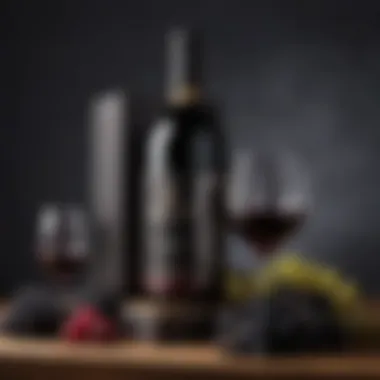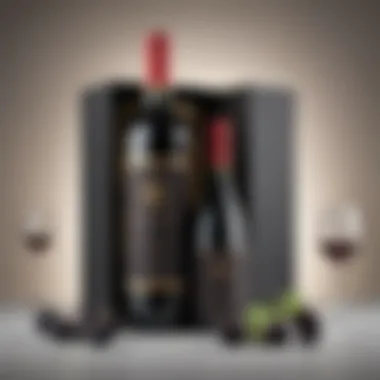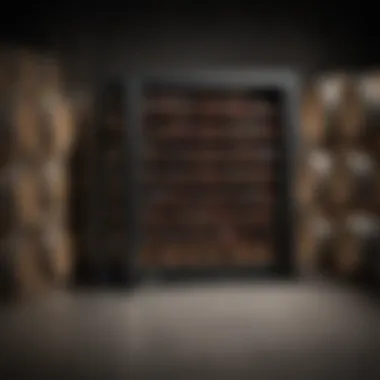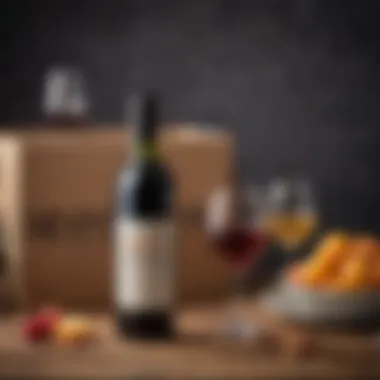The Lifespan of Black Box Wine: Preservation Insights


Intro
In recent years, boxed wine has gained significant traction among consumers, piquing the interest of both seasoned wine aficionados and casual drinkers. Unlike traditional bottle options, black box wine is encased in a durable package designed to preserve flavor and freshness for an extended period. This article explores various elements influencing the lifespan of black box wine, focusing on preservation techniques and storage methods that enhance enjoyment.
Understanding the factors that determine how long boxed wine lasts is crucial for maximizing its quality. Many misconceptions surround boxed wine, often being dismissed as inferior. In reality, black box wine can offer a delightful experience when properly cared for. By addressing the nuances between opened and unopened boxes, we aim to provide a clear perspective that benefits all wine enthusiasts.
We will also delve into best practices for storage to ensure that every pour tastes as good as intended. This comprehensive guide will serve as a valuable resource, highlighting key components such as shelf life, ideal conditions for maintaining quality, and steps to savoring black box wine at its best. Let’s embark on this journey of appreciation, enhancing not only understanding but enjoyment.
Understanding Black Box Wine
The appreciation of black box wine has grown over recent years, but its significance merits a deeper understanding. This segment serves to provide clarity on what black box wine is and why it has garnered attention in the wine market. Understanding the characteristics, advantages, and general perceptions surrounding black box wine offers insights that enhance the overall enjoyment and selection process for wine enthusiasts.
Black box wine represents a different approach to wine packaging, focusing on both convenience and preservation. The absence of glass bottles and corks introduces unique storage capabilities. As more consumers become informed about these aspects, the stigma previously attached to boxed wines diminishes. This section lays the foundation for appreciating the nuances of wine in a box, which is essential for both casual drinkers and seasoned aficionados.
What is Black Box Wine?
Black box wine refers to wine that is packaged in a box, typically consisting of a collapsible bladder inside a cardboard container. This design allows the wine to be dispensed through a tap mechanism, which prevents air exposure and oxidation for extended periods. Unlike traditional bottles, which can allow for oxidation once opened, the black box system preserves the wine's quality more effectively until it is consumed.
The volume usually contained in black boxes ranges from three liters to five liters, making them a practical choice for gatherings or casual enjoyment. This large capacity is often accompanied by cost-effectiveness, as boxed wines tend to be more affordable than their bottled counterparts. Importantly, black box wine can maintain its quality for months or even years when unopened, which appeals to budget-conscious consumers.
Popular Varieties in Black Box Packaging
Many wine varietals are now available in black box form, covering a broad spectrum of tastes and preferences. Common varieties include:
- Chardonnay: Known for its versatility and range of flavors from buttery to fruity.
- Cabernet Sauvignon: A full-bodied red wine that many enjoy for its rich taste.
- Merlot: Soft and approachable, appealing to newcomers and connoisseurs alike.
- Sauvignon Blanc: An option for those who prefer crisp and refreshing whites.
The increasing selection of black box wines enables consumers to experiment and find their preferred flavors without significant investment. Moreover, the perception of boxed wine is evolving, as producers focus on quality and craftsmanship, making it a viable choice in a diverse wine market.
Factors Affecting Longevity
The longevity of black box wine is not simply a matter of the wine itself; several interrelated factors play a critical role in determining how long it can maintain its quality. Understanding these factors is crucial for both wine enthusiasts and casual drinkers who wish to savor their wine without compromising its integrity. The main aspects influencing the lifespan include the type of wine, storage conditions, and the technology used in packaging. Each plays a significant role in preserving the delicate flavors and aromas that one expects from wine.
Type of Wine and Its Composition
The type of wine contained within the black box has a direct impact on how long it will last. Different varietals have unique characteristics that affect their longevity. For example, robust reds like Cabernet Sauvignon often have a longer lifespan due to their higher tannin content, which acts as a natural preservative. In contrast, lighter wines, such as some white varietals, may have a shorter shelf life and will be best consumed sooner. Higher acidity in wines often contributes to longevity, balancing the effects of oxidation.
Also, the composition of the wine, including its sugar and alcohol levels, plays a vital role in preservation. Sweet wines like Port or Sauternes tend to last longer, given their high sugar content. Meanwhile, dry wines without significant residual sugar will typically require more attention to maintain freshness.
Storage Conditions
Where and how black box wine is stored significantly influences its longevity. Ideally, the wine should be kept in a dark, cool environment. Excessive light and heat can lead to rapid deterioration of quality. Fluctuations in temperature can also be problematic. Maintaining a consistent temperature between 50-60 degrees Fahrenheit is generally recommended.


Moreover, humidity levels should be kept around 70% to prevent the evaporation of the wine and cork degradation. Black box wines, however, are often equipped with a spout that minimizes contact with air, which reduces the risk of spoilage due to improper storage. Following these guidelines will ensure that the wine remains enjoyable for an extended period.
Packaging Technology
The innovation behind black box wine packaging is a critical factor in its longevity. The bag-in-box design used in black boxes is specifically meant to limit oxygen exposure once the product is opened. This design helps maintain flavor integrity, preventing oxidation. The materials used in these boxes are also significant; many feature protective layers to guard against UV light, which can degrade wine quality over time.
"Proper packaging not only protects the wine but also enhances its shelf life, allowing it to remain fresh longer than traditional bottles."
Shelf Life of Unopened Black Box Wine
The shelf life of unopened black box wine is a crucial aspect to consider when exploring the preservation and enjoyment of this packaging style. Understanding how long these wines can remain sealed without losing quality provides essential guidance for both wine enthusiasts and casual drinkers. Proper awareness of the shelf life ensures that consumers are not only enjoying the wine at its best but also making informed choices when purchasing and storing their selections.
When kept in ideal conditions, unopened black box wine can often last several months, or even longer, depending on the specific varietal. This durability is a significant advantage of black box packaging compared to traditional bottles, as the packaging aids in maintaining the wine's integrity. It is also less prone to oxidation, allowing for a smoother transition between production and consumption.
Average Longevity of Different Varietals
The average longevity of black box wines depends largely on the type and composition of the varietal. Here are some considerations:
- Cabernet Sauvignon: Typically, this wine can last up to 12 to 18 months while unopened. Its robust nature benefits from black box packaging that prevents oxygen exposure, thereby enhancing the aging process.
- Chardonnay: Unopened, Chardonnay can generally last about 6 to 12 months. Those produced in a more fruity style might have a shorter shelf life, while oak-aged varieties could sustain quality for longer.
- Merlot: Similar to Cabernet Sauvignon, Merlot also holds well for about 12 to 18 months. The tannins and structure of the wine provide good preservation during storage.
- Syrah/Shiraz: This varietal typically can last around 12 months when unopened, but well-made versions might go longer, depending on storage conditions.
"Understanding the specific varietal is key to extending the shelf life of your black box wine."
Indicators of Quality in Boxed Wine
Indicators of quality in boxed wine are subtle yet insightful. A few key aspects to monitor include:
- Packaging Integrity: Ensure the box is not damaged. Any punctures or tears can lead to oxidation.
- Visual Clarity: Inspect the inner bladder if possible. The wine should be clear without sediment or cloudiness.
- Color: For white wines, an overly dark or yellow hue might suggest age or improper handling. For reds, a vibrant color generally indicates freshness.
- Taste Profile: While the wine is unopened, it is difficult to gauge taste without sampling. However, select reputable brands and vintages to ensure better quality assurance.
By focusing on the shelf life of unopened black box wine and its specific indicators of quality, consumers can enjoy their wines at the peak of freshness. Proper choices in varietals and attention to packaging integrity are practical steps toward maintaining a quality wine experience.
Shelf Life After Opening
Understanding the shelf life after opening black box wine is essential for maximizing both its quality and enjoyment. Once the box is unsealed, the wine is exposed to air, initiating a process that can significantly affect its taste and freshness. This section explores the duration of freshness once opened, along with signs of spoilage to watch for, ensuring that wine enthusiasts can appreciate their selection at its best.
Duration of Freshness once Opened
Generally, once you open a black box of wine, it can maintain its freshness for approximately three to six weeks. This adaptability arises from the innovative packaging technology used in black box wines. The inner bladder contracts as wine is poured, minimizing exposure to air and thereby slowing oxidation. Red wines, like Cabernet Sauvignon and Merlot, might last longer compared to whites, such as Sauvignon Blanc or Pinot Grigio, due to their higher tannin content.
To achieve the best taste during this time, it is recommended to keep the box in a cool, dark place. Here are some tips to extend the viable lifespan of opened black box wine:
- Keep the Box Sealed: Ensure that the tap remains closed when not in use to minimize air exposure.
- Store Upright: This prevents leakage and keeps the spout clean.
- Monitor Temperature: Avoid placing the box near heat sources or in direct sunlight, as this can influence the flavor.
Signs of Spoilage in Boxed Wine


Recognizing spoilage in black box wine is equally important. Although boxed wine has a reputation for being more resilient, it is not immune to the ravages of oxidation and other factors. Here are key indicators of spoilage:
- Off Smells: A sour, vinegar-like smell or an aroma reminiscent of wet cardboard indicates the wine may be past its prime.
- Flavor Changes: A noticeable shift toward bitterness or an unpleasant aftertaste is a significant warning sign.
- Color Alterations: If the wine appears darker or muddy, it may signify oxidation.
- Sediment: While some sediment is normal, excessive particles can indicate spoilage.
Regular tasting during the freshness period can help you evaluate the wine and catch any changes early.
By being aware of these signs and understanding how to properly store opened wine, consumers can ensure that they enjoy their black box selections at their best, enhancing the overall experience.
Best Practices for Storage
Understanding the best practices for storage of black box wine is essential for anyone who wants to preserve its quality and enhance its enjoyment. Proper storage can make a significant difference in the lifespan of the wine and its flavor profile. In this section, we will explore optimal conditions for storage, including environment factors and handling techniques that keep the wine in the best possible condition.
Optimal Conditions for Wine Storage
To maximize the longevity of black box wine, it is crucial to identify optimal storage conditions. Keeping wine in a controlled environment helps maintain its integrity. Here are some key elements to consider:
- Humidity: An ideal humidity level is between 50-70%. High humidity can damage labels and packaging, while low humidity can dry out the wine’s seal, allowing air to seep in.
- Temperature: The temperature should remain stable, ideally between 50-55°F. Fluctuating temperatures can cause expansion and contraction of the liquid, which may lead to oxidation or spoilage
- Air Quality: Wine should be kept in a well-ventilated area to minimize exposure to unwanted odors from other products. Strong smells can affect the taste of the wine.
In addition, placing the box horizontally allows for better contact between the wine and the bag lining, which helps maintain freshness.
Temperature and Light Considerations
Temperature plays a vital role in preserving black box wine. Exposure to excessive heat can hasten spoilage and lead to off-flavors. Similarly, light, especially UV rays, can cause negative reactions in the wine. Therefore, the following points are crucial:
- Avoid direct sunlight: Store boxed wine in a dark place. A closet or pantry that is cool and dark is often ideal.
- Consistent temperature control: Avoid areas near appliances like refrigerators or ovens that can cause temperature fluctuations.
- Use a thermometer: Monitor the storage environment. A simple digital thermometer can be a valuable tool to ensure conditions remain ideal.
By taking these storage practices into account, wine enthusiasts can enjoy their black box wines at their best quality over time. Following these guidelines safeguards against premature spoilage and ensures a satisfying drinking experience.
"Proper storage can enhance the lifespan and quality of your wine, making each pour a true delight."
Comparative Analysis with Bottled Wine
The exploration of black box wine in relation to bottled wine provides valuable insights for consumers. Understanding the distinctions in longevity and flavor preservation can inform purchasing decisions. Black box wine often benefits from innovations in packaging, while traditional bottles have their own merits. Analyzing these factors helps to clarify what consumers can expect when choosing between these two formats.
Shelf Life: Box vs. Bottle
Black box wine typically enjoys a longer shelf life compared to its bottled counterparts. This is due in part to the packaging technology used. Bag-in-box systems reduce oxygen exposure, which is a primary factor in wine spoilage. Sealed in airtight conditions, black box wine can last several weeks after opening, preserving its taste much longer than open bottles, which usually begin to degrade in a few days.
Conversely, bottled wine can have unpredictable longevity, depending on various factors like cork quality and storage conditions. While some premium bottles may mature favorably over time, others may spoil if left unopened beyond their intended lifespan.
Black box wine's innovative packaging allows for extended longevity, making it an appealing option for casual wine drinkers.


Flavor Profile Preservation
When it comes to flavor profile, black box wine often stands out. The packaging is designed to minimize air exposure, thus maintaining the wine's intended taste longer. The controlled environment inside the box means that oxidization, which can alter flavors, is significantly limited.
On the other hand, bottled wine can exhibit a wide range of flavor profiles depending on the quality of the closure and the conditions in which it is stored. A cork can degrade over time, letting in air that leads to oxidation and spoilage. Some bottled wines do have the potential for complex aging, but this process can be highly variable and requires careful consideration.
In summary, while boxed wine may not satisfy connoisseurs seeking long-term aging potential, it excels in ease of enjoyment and practicality. The choice largely depends on the consumer's needs and preferences.
Consumer Perceptions and Misconceptions
Understanding consumer perceptions of black box wine is crucial. This section addresses the common views and misunderstandings surrounding boxed wines. It provides insights that can help demystify the stigma often attached to these products. Consumers play a vital role in shaping market trends. Their opinions directly impact sales and the overall acceptance of boxed wines in society.
Boxed Wine Stigmas
Boxed wine has historically been viewed unfavorably by many wine enthusiasts. The general perception is that it is of lower quality than traditional bottled wines. This belief can stem from the origins of boxed wines, which often targeted a budget-conscious market. Keywords like "cheap" and "low quality" frequently accompany discussions about boxed wine.
The stigma also aligns with the traditional wine culture that emphasizes exclusivity and sophistication. Some consumers believe that if a wine is packaged in a box, it cannot offer the same complexity or flavor profile as bottled wine. This notion is not entirely accurate. Many boxed wines now come from reputable vineyards and producers, offering excellent quality.
Moreover, the environmental benefits of boxed wine are often overlooked. The packaging is more sustainable than glass bottles, making it an eco-friendly choice. Not only do these boxes use less material, but they are also lighter, reducing transportation emissions.
"Boxed wines are not just for picnics anymore; many are crafted to be enjoyed and appreciated."
Changing Attitudes towards Black Box Wine
Over recent years, there has been a marked change in attitudes towards black box wine. The shift is driven by several factors, such as marketing advancements and improved quality control among producers. Many consumers now view boxed wines as a viable option, especially for casual drinking occasions.
Educational campaigns about wine packaging and tasting notes have contributed to this transformation. Consumers are increasingly informed about how to identify quality in wine, regardless of its packaging. The perception of boxed wines as inferior is slowly fading.
Social media also plays a significant role in changing these attitudes. Users share their experiences and preferences online, showcasing high-quality boxed wines. This trend encourages others to give boxed wines a chance, breaking down previously held stigmas.
There are benefits to opting for boxed wine. Not only is it often more budget-friendly, but it also offers convenience. Boxes can remain fresh longer after opening, which appeals to many consumers who want to enjoy wine over an extended period.
In summary, while stereotypes about boxed wines persist, changing consumer attitudes are reshaping perceptions. Engaging with these wines can lead to discoveries of quality and enjoyment previously underestimated.
End and Recommendations
Black box wine has increasingly gained a foothold in the consumer market. As enthusiasts and casual wine drinkers seek to maximize their experiences, understanding the longevity and preservation of these products becomes essential. This section aims to distill the critical elements of longevity and offer actionable recommendations for both novice and seasoned wine drinkers.
The shelf life of black box wine is influenced by several factors. One should consider the type and composition of the wine, as different varietals possess unique characteristics that affect aging potential. Furthermore, storage conditions play a significant role; maintaining appropriate temperature and light exposure is crucial for preserving wine's quality. Lastly, the innovative packaging technology used in black box wines provides additional protection compared to traditional bottles, enhancing their lifespan.
Key Takeaways on Longevity
- Average Longevity: Most black box wines can maintain their quality for one to two years when unopened. Varietals such as Cabernet Sauvignon or Merlot usually last longer compared to lighter options, like Pinot Grigio.
- Opened Shelf Life: Once opened, black box wine can remain fresh for a span of three to six weeks, depending on factors such as refilling the bag and minimizing air exposure.
- Visual and Sensory Indicators: Watch for changes in color or sediment, and pay attention to aromas. Off-smells or taste indicate spoilage and should be taken seriously.
- Storage Environment: Wine should be stored in a cool, dark place, ideally between 50-60°F (10-15°C).
- Packaging Benefits: The airtight system in black boxes reduces oxidation risks, which can preserve flavor and aroma better than traditional bottles in certain scenarios.
Final Thoughts on Enjoying Black Box Wine
The black box format serves not just as a practical alternative but also as a bridge to a broader wine culture. Its increased acceptance reflects changing perceptions about boxed wines, once stigmatized but now recognized for their quality and convenience. With several findings clear from this article, the goal is to empower consumers to choose based on informed preferences rather than misconceptions.
- Quality over Quantity: Select wines from reputable brands that prioritize quality in both the wine and the packaging.
- Serve Properly: Even box wine can elevate occasions. Use a clean glass, and don't skip on aeration if necessary.
- Engage and Explore: Use black box wine as an opportunity to explore lesser-known varietals without the commitment of purchasing a full bottle.







